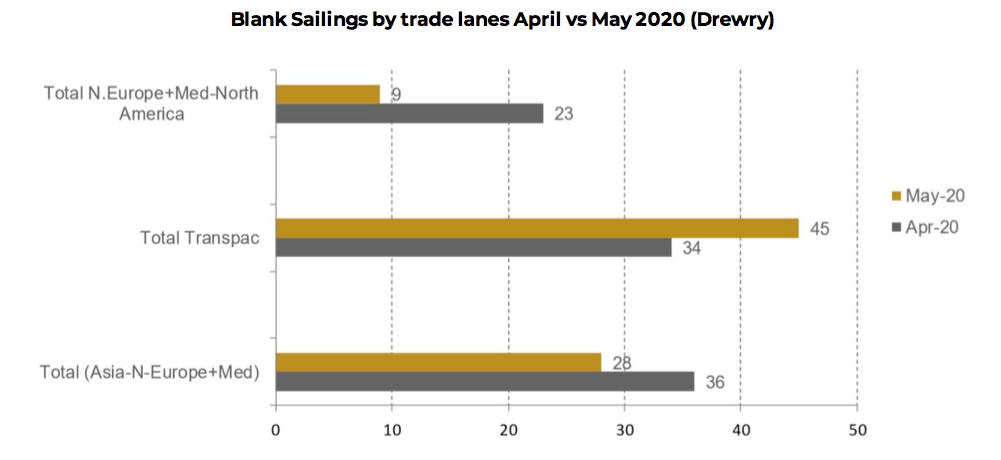
Shipping & Logistics
The International Transport Forum claims that, as a result of Covid-19, global container trade volumes declined by 8.6% in February 2020 and the reduction is likely to be larger in the following months.
The main response of carriers to falling demand has been to reduce supply: cancellations concern up to 30% of the Far East-Europe service capacity and up to 20% of the Trans-Pacific service capacity.
Drewry confirms that global carriers will continue to make large-scale service cancellations in the coming months and argues that in the long run this policy could force shippers and receivers to reshape their supply chain through longer lead times in order to deal with possible delays.
On the main East-West routes cancellations in May will consistently exceed those of the same period last year: 73 vs 13. The Transpacific route continues to pay the heaviest toll with 45 cancellations, while on FE- MED routes 28 cancellations are expected in May, improving from 36 registered in April. Today, the overall capacity towards the Mediterranean from Far East stands below 500 thousand TEU per month (-19%).
The situation is improving also on the Transatlantic route, with only 9 services cancelled in May against 23 in April.

ITF states that despite reduced demand and reduced service offer, customers of container shipping services have not benefitted from lowered tariffs, as the system of alliances and consortia managed to control prices and avoid the collapse of freight rates.
Furthermore, lower demand for container shipping caused less activity in container ports (global container throughput dropped by 6% in both February and March) and increased the bargaining power of carriers vs terminals.
JOC claims that the closure of retail outlets across Europe and North America since early March has erased consumer demand and stopped manufacturing in many parts of the world. But, according to forwarder association FIATA, cargo (and particularly non-essential products) has been steadily building up in warehouses, port terminals, and inland depots during the lockdowns. Some carriers (CMA CGM, MSC, Maersk) are offering “Delay in Transit” options allowing shippers to store import containers at transhipment hubs as cargo owners adjust supply chains in response to COVID.
Europe’s hub ports appear to be more affected by an accumulation of cargo than those in North America. All the cargo that left China in March after factories reopened arrived in Europe by mid-April, but containers will not be emptied and returned to service soon, worsening a container imbalance that has always existed on the Asia-Europe due to increasing vessel sizes, consolidation, and shipping alliances.
European supply chains
According to the in-depth analysis by Oxford Economics, the widespread lockdowns are hitting domestic economies and a recovery in H2 could be menaced by bottlenecks in global supply chains. In response to the global coronavirus pandemic, the UK-based economic research company has revised down the EU-27 GDP growth forecast from 1.2% in 2020 to -4.8% , a much sharper recession than in 2009.
The EU is significantly more integrated into global supply chains than the US and China. The EU contributes over 30% to global core intermediate goods exports (the equivalent figure for China is just over 10%) and shutdowns in Europe would cause severe disruptions all over the world.

Over a quarter of the EU’s total comes from Germany and the second exporter is Italy. Economies most exposed to delays in the EU supply-chain disruption are EU peripheral countries (Poland, Czech Republic, Austria, Hungary, Romania, and the Nordics) and the most integrated non-EU economies (Switzerland, Turkey, Russia, Norway, and Morocco) plus the UK, which in 2018 imported 60% of intermediate goods from the EU. As EU also imports a large portion of goods used in production, extended lockdowns would then prevent a quick restart for exporters from the same economies.
Ports of Genoa
Containers shipped via rail to and from the Ports of Genoa recorded a positive result in Q1 2020 (+1.9% vs 2019) although the trend is decreasing. In fact, during the first two months of the year, rail traffic volumes increased considerably both in Genoa (+10%) and in Savona, where the new APM Terminal’s Vado Gateway, opened for service on February 12 and registered a rail ratio of over 40%, well above the strategic goal declared by the Company.
In March, however, in addition to the reduction in the hinterland volumes due to the COVID crisis, railway transport from the Genoa port basin was affected due to the ongoing new motorway bridge construction works which caused the temporary closure of the underlying railway section.
In Q1 an overall 78,188 TEUs were transported by train (a 13.5% share of the total gateway container traffic). Despite the general reduction in transport demand, the railway service level was improved through higher frequencies and the number of trains grew by 7.6%.

In terms of inland destinations, data confirm that railway transport is more competitive over longer distances. In fact, railway connections with Piedmont, the closest region to the Ports of Genoa, are mostly related to shuttling operations to the Rivalta Scrivia intermodal centre.
Lombardy is the main hinterland market of the port of Genoa, accounting for about 50% of incoming and outgoing volumes, but this percentage drops to 38% with reference to rail transport, which holds a 10.6% share vs road. More distant regions, as Veneto and Emilia Romagna, show higher rail ratios (34.9% and 30.4% respectively).




